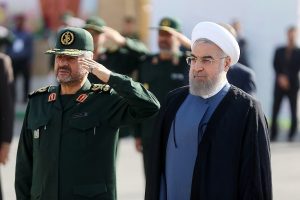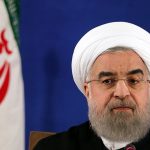by Derek Davison
On Sunday evening The Daily Beast published a first-person account by its senior intelligence and national security correspondent, Shane Harris, with the gripping title “Iran’s Spies Tried to Recruit Me.” No, Iran’s Ministry of Intelligence didn’t ask Harris to steal any classified documents or carry out any covert operations on US soil. In fact, Harris never actually establishes that “Iran’s spies” were the ones who contacted him. But the piece is an interesting look at how a foreign government or foreign organization might engage an American journalist to produce what amounts to propaganda on behalf of another country.
Since it’s dealing with Iran, though, Harris’s piece occasionally veers off into what I’m going to call “Iran Derangement Syndrome” (IDS). A person suffering from IDS is frequently inclined to treat Iranian statements or actions as uniquely sinister or provocative, even when those statements or actions are no different from what any other nation might say or do, or has said or has done. IDS has been somewhat less prominent in the mainstream US media since the 2013 election of moderate Hassan Rouhani as Iran’s president and the subsequent negotiations over Iran’s nuclear program (which are scheduled to reach a conclusion at the end of this month). But it was frequently observed during the presidency of Mahmoud Ahmadinejad, when US-Iran relations were considerably more tense.
In a 2012 piece for Salon (referring specifically to this NBC News report), Glenn Greenwald described the phenomenon:
We’re told that if the U.S. ends up in a war with Iran, then “the U.S. Navy’s Fifth Fleet would be the world’s first line of defense“: because Iran is threatening the entire world, and the U.S. would be defending “the world” from this grave Persian menace. Then there’s the ominous claim that “Iranian leaders have threatened all-out war”: but that’s “if Israel launches air strikes against Iran’s nuclear program,” which would already itself be “all-out war.” The NBC story — which begins with video shots of Iranians in lab coats lurking around complex, James-Bond-villain-like nuclear-ish machines — ends with twenty seconds of scary video footage of Iranian missiles being launched, accompanied with this narration: “U.S. officials warn that Iran’s massive stockpile of ballistic missiles is the more serious threat”; after all, “within just the past few days, Iranian leaders [cue video of a scary, ranting Ahmedinijad] have threatened that if attacked, they would launch those missiles at U.S. targets.”
It’s just remarkable to watch the American media depict Iran as the threatening, aggressive party here. Literally on a daily basis, political and media figures in both the U.S. and Israel openly threaten to attack Iran and debate how the attack should happen with a casualness that most people use to contemplate what to have for lunch.
Conference Presenter or Spy?
Harris writes that someone representing the “International Congress on 17000 Iranian Terror Victims” invited him to submit a paper for the group’s annual conference in August. After noting the inflammatory nature of the conference’s list of topics, he checked into the conference’s sponsors and found ties to the Iranian government:
But then I looked closely at the list of conference sponsors, which includes—among various religious groups, Iran’s only broadcasting company, and a government council run by a senior adviser to Supreme Leader Ali Khamenei—Iran’s Ministry of Foreign Affairs. As in the ministry now negotiating with the U.S. over the future of Iran’s nuclear program. Also, the head of Iran’s intelligence service spoke at last year’s event.
Harris communicated further with his contact and was given a choice of topics about which he might write:
A day later, I heard back from my would-be publisher/host in Iran (who never identified himself or herself by name).
“We heave [sic] three offers for you:
-
Examine the us. and Israel campaign to undermine the Iranian nuclear program, including state sponsored assassination of Iranian nuclear scientists and sabotage of Iranian nuclear centrifuges.
-
Why is there a different us. attitude toward Israel’s substantial nuclear arsenal compared to Iran’s?
-
Fueling Iranophobia under the pretext of “Diversion of Iran’s nuclear program to military[.]”
The contact also promised Harris free travel to Iran should he wish to attend the conference and offered “in principle” (though no specifics were discussed) to pay him for his piece. This isn’t exactly Casino Royale-type stuff, but it’s pretty fascinating in its own right. It’s here, however, where Harris’s piece begins to lose the plot. First he describes the organization that appears ultimately to be behind the conference:
Throughout my exchange, the question of who, exactly, was organizing this event was difficult to nail down. While the conference has the support of high-level government officials and ministries, it’s nominally run by a group called the Habilian Association.
That group is run by family members of people who died in terrorist attacks, notably those that Habilian alleges were committed by the Mujahedeen-e-Khalq, or MEK, an exiled Iranian resistance group that wants to see democratic, non-theocratic rule brought to Iran.
The MEK Connection
Although MEK undoubtedly appreciates seeing itself described as a “group that wants to see democratic, non-theocratic rule brought to Iran,” Harris should perhaps have been a little more circumspect in his writing. He might have noted any of the vast number of critical commentaries that have been written about MEK over the last several years. For example, in 2005 Human Rights Watch documented repeated human rights abuses within MEK’s camps in Iraq. Harris might have mentioned that. Or he might have found this New York Times piece from 2011, in which MEK is described as “a fringe Iranian opposition group, long an ally of Saddam Hussein, that is designated as a terrorist organization under United States law and described by State Department officials as a repressive cult despised by most Iranians and Iraqis.” MEK is no longer designated as a terrorist organization, thanks to an impressive lobbying campaign to have the designation lifted, but it stretches credulity to describe them the way Harris did.
Harris then slips firmly into IDS territory. Ali Safavi, a member of MEK’s umbrella organization, the National Council of Resistance of Iran, warned Harris that Habilian “has tried to influence journalists, opinion leaders, and Iran observers through a steady diet of misinformation disseminated by its paid and unpaid surrogates outside Iran.” This is a serious charge, but it would probably carry more weight if NCRI and MEK didn’t do, well, exactly the same thing. But Harris’s case of IDS only gets worse:
The MEK—which until 2012 the United States officially listed as a terrorist organization—stages it own large conference every year, in Paris, which draws a wide range of former U.S. officials, many of whom are paid to give pro-MEK speeches. To Habilian, this probably looks as one-sided and tendentious as its own rants against the Zionist-controlled media and American foreign policy hypocrisy.
“[P]robably looks as one-sided and tendentious”? Could it be that it…is exactly as one-sided and tendentious? The only difference here seems to be that Habilian recruits Americans who champion outrageous fringe conspiracy theories (one of their past contributors is a Sandy Hook “Truther”), while MEK has been able to hire some of the highest-profile figures in American politics to lobby on its behalf.
The rest of Harris’s piece is devoted to trying to puzzle out what the “International Congress” and several similar Iranian events are all about. But it’s not clear why this is a big mystery, except insofar as Iran is behind these events and therefore, per IDS, they must have some ultra-devious purpose. Foreign governments often pay for propaganda, including from American journalists.
For example, several right-leaning American journalists were caught up in a 2013 scandal when it was found that they were receiving payment from the government of Malaysia in exchange for writing pieces that were critical of Malaysian activist Anwar Ibrahim. Last year, The New York Times conducted an investigation into the millions of dollars that foreign governments have paid to Washington-based think tanks in order to push policies favorable to those foreign nations. Israel’s “public diplomacy” (i.e., propaganda) campaign is so robust that it has its own term, hasbara, and Zionist organizations also hold annual conferences intended to push their own agendas. Israel’s Ministry of Foreign Affairs has even co-sponsored an organization called “Hasbara Fellowships” that, according to its own website, “brings hundreds of students to Israel every summer and winter, giving them the information and tools to return to their campuses as educators about Israel.”
Nor is this sort of activity limited to foreign governments. A 2008 New York Times investigation revealed that the Bush administration employed a vast network of surrogates, mainly paid lobbyists for defense contractors, to flood airwaves both in the US and overseas with its own carefully crafted public messages on subjects like the Iraq War and the Abu Ghraib prison scandal. Outside of government, of course, this sort of paid propaganda is ubiquitous. In 2010, for example, ThinkProgress uncovered the US Chamber of Commerce’s substantial operation to manipulate media and even Internet search engines. Again, governments and large organizations pay for propaganda all the time. Unless you’re one of the many American commentators still tragically suffering from IDS, there’s nothing particularly unusual about Iran doing the same thing.






Good bless than, he nailed it. The narrative on Iran well known to Iranian Americans. IDS is definite disease that should be codified in the DSM. Sadly this is a self inflicted disease.